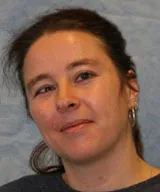Claudia Blindauer
Professor of Chemistry
 We are working in the field of inorganic biochemistry, focusing on metal-binding proteins from a variety of organisms including mammals, invertebrates, plants, and bacteria, with the aim to contribute to the understanding of mechanisms of zinc homeostasis.
We are working in the field of inorganic biochemistry, focusing on metal-binding proteins from a variety of organisms including mammals, invertebrates, plants, and bacteria, with the aim to contribute to the understanding of mechanisms of zinc homeostasis.
Protein structure, dynamics of metal uptake and release, and biomolecular interactions are studied using recombinant protein expression and purification, multinuclear NMR, mass spectrometry, optical spectroscopies, multi-elemental analysis, chromatography, and most recently metalloproteomics.
See our Research Pages for more information.
C dot Blindauer at warwick dot ac dot uk
02476 5 28264
Office C5.10
My research group pages: Blindauer Group
Biography
June 2020: Professor of Chemistry
2012-2020: Reader in Chemistry
2008-2012: Associate Professor of Chemistry
2004-2008: Assistant Professor of Chemistry
Oct 2004-Sept. 2009: Royal Society Olga Kennard Research Fellow
1999-2004: Post-doctoral studies at the University of Edinburgh
1994-1999: PhD and Post-doctoral studies at the University of Basel, Switzerland
1994: Diplom Chemie, Albert-Ludwigs-Universitart Freiburg im Breisgau, Germany
I am working on the following projects at the moment:
- Project number 1
- Project number 2
- Project number 3
Current projects:
Plasma zinc speciation and its biomedical implications (in collaboration with Dr Alan Stewart, St Andrews, and Dr Hugo van den Berg)
Zinc homeostasis and its regulation in marine cyanobacteria (in collaboration with Prof David Scanlan, Warwick SLS)
Plant metallothioneins and their impact on edible seeds (in collaboration with Dr Agnieszka Mierek-Adamska, University of Torun, Poland, and Dr Jose Gutierrez-Marcos)
I am giving tutorials in 1st and 2nd year Inorganic Chemistry, teach a 3rd year module (CH3F8) in Advanced Coordination and Bio-Inorganic Chemistry, and a postgraduate taught module on Analytical Methods (CH921; Frontiers in Analytical Science).
I am supervising the following PDRAs:
- Dr Lizzie Bolitho (A quantitative framework linking extracellular zinc speciation and cell uptake; funded by the Leverhulme Trust)
I am supervising the following PhD students:
- Linda Westermann (Bacterial phosphatases and their metal requirements; main supervisor: David Scanlan, SLS; CAB is co-supervisor)
- Azzobir Emhemed (Metal-binding by cysteine-rich proteins and peptides)
We are always interested in considering applications from students excited by our work, and in principle are able and willing to support your application for studentships.
K. B. Handing, I. G. Shabalin, O. Kassaar, S. Khazaipoul, C. A Blindauer, A. J. Stewart, M. Chruszch and W. Minor, Chem. Sci., 2016, DOI: 10.1039/C6SC02267G.
Unexpected Interactions of the Cyanobacterial Metallothionein SmtA with Uranium.
Identification of major zinc-binding proteins from a marine cyanobacterium: insight into metal uptake in oligotrophic environments.
J. Lu, A. J. Stewart, D. Sleep, P. J. Sadler, T. J. T. Pinheiro, and C. A. Blindauer. J. Am. Chem.Soc. 2012, 134, 1454–1457. DOI: 10.1021/ja210496n.
O. I. Leszczyszyn, S. Zeitoun-Ghandour, S. R. Stürzenbaum and C. A. Blindauer. Chem. Commun., 2011, 47, 448-450. DOI: 10.1039/C0CC02188A.
C. A. Blindauer, O. I. Leszczyszyn, Nat. Prod. Rep. 2010, 27, 720-741.
